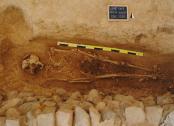CAMPAGNA 2018 |
1° SETTIMANA |
2° SETTIMANA |
3° SETTIMANA |
4° SETTIMANA |
5° SETTIMANA |
6° SETTIMANA |
7° SETTIMANA |
8° SETTIMANA |
9° SETTIMANA |
27 GIUGNO 2018 
Resoconto della giornata di scavo
Area 3000
Nella porzione sud-orientale del Settore B si è proceduto con la messa in luce completa dell’individuo USK 3889, orientato W-E e deposto in decubito dorale all’interno della fossa sepolcrale US – 3887. L’inumato, una donna adulta, si presenta con il cranio in apparizione laterale sinistra, gli arti inferiori leggermente flessi con le mani in corrispondenza dei femori e gli arti inferiori distesi, con le caviglie ed i piedi vicini. La decomposizione del corpo sembra essere avvenuta in spazio parzialmente vuoto, come sembra suggerire l’apertura della mandibola, l’appiattimento del torace e del bacino, la disarticolazione del gomito sinistro e la generale lassità delle articolazioni. Si può ipotizzare che l’individuo sia stato deposto originariamente all’interno di una cassa lignea, ormai decomposta e la presenza di quest’ultima, unita alla posizione della fossa sepolcrale stessa, proprio di fronte alla facciata della chiesa di XI secolo, suggerirebbe l’importanza della sepoltura. Nella porzione nord-occidentale è stata completato lo scavo di USK 3905, orientato W-E e deposto supino in US – 3895. L’individuo si presenta in cattivo stato di conservazione, con il cranio molto frammentato, l’arto superiore destro piegato su se stessa con la mano in corrispondenza della spalla ed il braccio sinistro leggermente flesso sul pube. Gli arti inferiori sono distesi con le caviglie ed i piedi divergenti. Si nota una generale compressione laterale del corpo, forse dovuta alla presenza originaria di un sudario, ormai scomparso. Nel corso della giornata di domani si procederà con la documentazione e successiva rimozione di entrambi gli individui suddetti.
Today at the site the 3889 skeleton was fully exposed. GIS measurements and photographs were taken of the skeletal material and the skeletal context sheets have begun. In fill 3902 the skeleton is still being exposed and the grave is leveled. The 3905 skeleton within the 3896 fill was fully exposed and photographs and GIS measurements were taken. The skeletal context sheets were started and the removal of 3905 has started with the metatarsals in the feet.
Area 5000
Today the students working in the cut in section D revealed multiple bone fragments, teeth, brick fragments, a piece of glass, two flint fragments, and the edges of some stone pieces (one of which was slate) that extended nearly vertically downward. The students in section C cleaned the area from the trench to the southern edge and wetted it to take pictures. After the pictures were done the students excavated the remaining portion of the second cranium revealing a mandible that was then excavated as well. The students also excavated multiple very fragile bones and some additional bone fragments and teeth. Some students worked in the trench digging holes.
Area 6000
One member of our group continued with and finished her GIS lab today. This consisted of working with the CAD program, as well as GIS, and finished with tracing and labeling skeletons in GIS. In addition, she did additional point-taking and practiced with the Total Station again. Another member of the group continued and finished the Osteology lab today, continued cleaning the bones from a reduction, and later put the fragmented pieces together. Lastly, she determined the age and sex of a partial cranium and pelvis.
Two members of the group continued to work on burial 6204 by cleaning up the remains and clearly revealing the edges of each bone. The left hand was found wrapped around the left femur in clear definition. Near the end of the day the cleaning was completed, so the corners of the burial and the elevations of the remains were taken using the Total Station and photographs were taken. Tomorrow we will fill out the context sheet for this burial and then remove the remains from the burial.
Two members of the group continued to work on burial 6215. They finished filling out the context sheet and began to remove the remains from the burial. Many of the bones that were removed were fragment upon removal while a few where already fragmented before it was removed. All elements of the lower limb, the os coxae, and several of the hand bones were removed, wrapped in cloth, and labeled. A soil sample was also taken from beneath the os coxae as soon as they were removed so that the soil can be analyzed for bacteria and evidence of the individual’s diet.
Another two members of the group worked in area 6215, and at this point, were wary of whether or not this area was a burial. The reason we thought this was because the femur, tibia, and fibula that were found in articulation were positioned towards the right, and so we misidentified the leg as right; however, due to the positioning of the femoral head, we sided all the leg bones as left. Prior to this discovery, we believed that this wasn’t a burial, but just an amalgam of bones. Soon after, we realized that the clay directly beside it—which we initially believed was the cut—was in fact fill, and that there was a right femur and tibia present. (We have not yet uncovered a right fibula.











